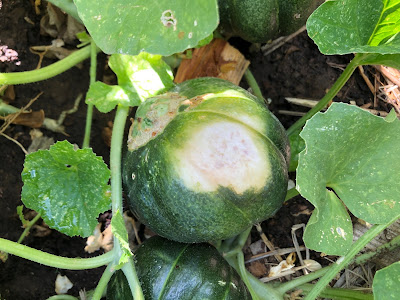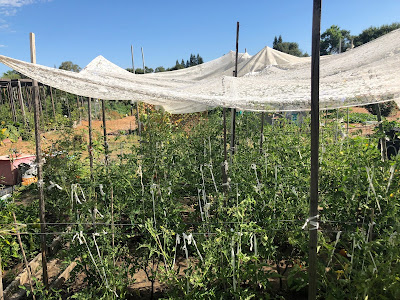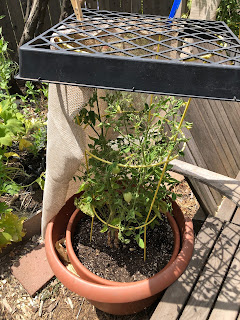
Quick help for plants in danger of sunburn
 |
|
Argh, this Noir Des Carmes melon became sunburned before I could
protect it. (Photos: Kathy Morrison) |
Venture outside in this heat without a hat and sunscreen, and you know what you'll get: Sunburned skin.
Pity your plants, which can't don sun-protective gear or move into the shade. Yet they get sunburned, too.
Sunscald mars ripening tomatoes and peppers. Even melons get scorched in intense heat.
Here's the deal: Growing something that requires "full sun" doesn't always mean, in our climate, "full exposure to sun." Full heat may require some filtered afternoon shade.
 |
| Lace tablecloths filter the sun in a community garden plot. |
The experienced gardeners in my community garden have learned this. Some grow tomatoes under a wooden superstructure that shades the plants. Others hang shade cloth or frost cloth across the front of their tomato plants. A few have a sea of lace tablecloths floating on stakes over their veggies, giving the garden a refined air.
Frankly, I've given up trying to grow bell peppers and certain tomato varieties in full sun. My Robeson tomato, which does not like intense heat, is doing quite nicely this year in a large pot on the north side of a backyard crape myrtle tree. The peppers are also in pots, cozying up against rose bushes and dwarf citrus trees, which give just enough shade.
Are you seeing sunscald on your developing produce? Here are 5 hacks you can try now with items in your home or garden. Since they're not permanent solutions, be sure to plan for 2020: It's going to be just as hot next year.
 |
|
A plant flat anchors some shade cloth on
this Burbank tomato in a pot.
|
1) Use black plastic plant flats balanced on top of tomato cages. They fit, I found out in desperation one summer. Use them alone or to anchor a piece of burlap or shade cloth to protect peppers or small tomato plants.
2) Put paper hats on melons. Use junk mail envelopes (plain ones, not the ones with the windows) as quick paper hats or cones over your most-exposed little melons. Or fold a piece of newspaper into a tent for a larger melon.
3) Newspaper sections also work as quick, desperation shade, hanging off tomato cages and cucumber trellises. Light can't get through it at all, however, so replace it soon with something less opaque.
4) Are the plants growing up a fence or trellis? Use clothes pins to attach thin dishtowels (worn ones work best) to the trellis, hanging them over the veggies. This is good for cucumbers or any other climbing vegetables.
5) Bring tree shade to the veggies: Trim off just a foot or so of a thin leaf-filled branch from an ornamental tree and lay it carefully among ground-growing veggies, such as squash or melons. The leaves will filter the sun just enough.
Comments
0 comments have been posted.Sacramento Digs Gardening to your inbox.
Sites We Like
Garden Checklist for week of July 21
Your garden needs you!
* Keep your vegetable garden watered, mulched and weeded. Water before 8 a.m. to reduce the chance of fungal infection and to conserve moisture.
* Feed vegetable plants bone meal, rock phosphate or other fertilizers high in phosphate to stimulate more blooms and fruiting. (But wait until daily high temperatures drop out of the 100s.)
* Don’t let tomatoes wilt or dry out completely. Give tomatoes a deep watering two to three times a week.
* Harvest vegetables promptly to encourage plants to produce more. Squash especially tends to grow rapidly in hot weather. Keep an eye on zucchini.
* Pinch back chrysanthemums for bushy plants and more flowers in September.
* Remove spent flowers from roses, daylilies and other bloomers as they finish flowering.
* Pinch off blooms from basil so the plant will grow more leaves.
* Cut back lavender after flowering to promote a second bloom.
* It's not too late to add a splash of color. Plant petunias, snapdragons, zinnias and marigolds.
* From seed, plant corn, pumpkins, radishes, winter squash and sunflowers.